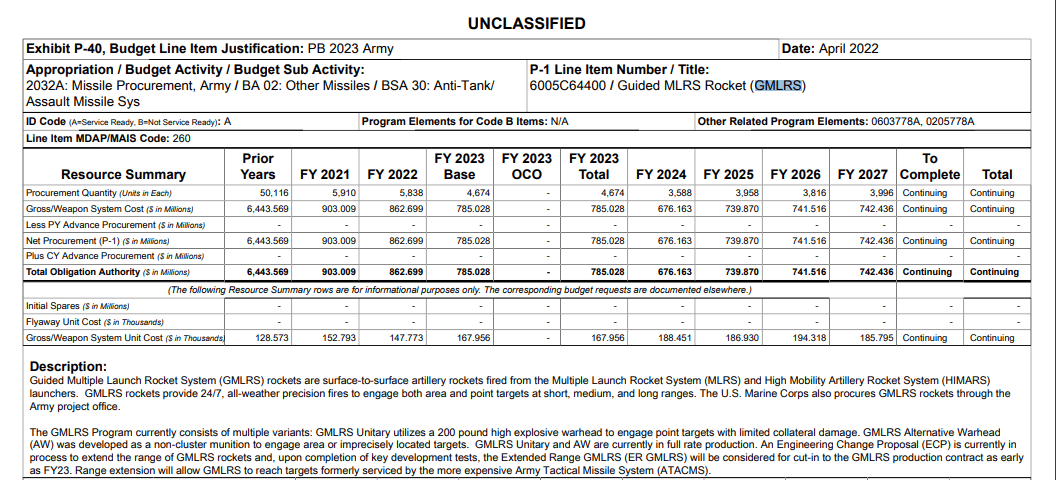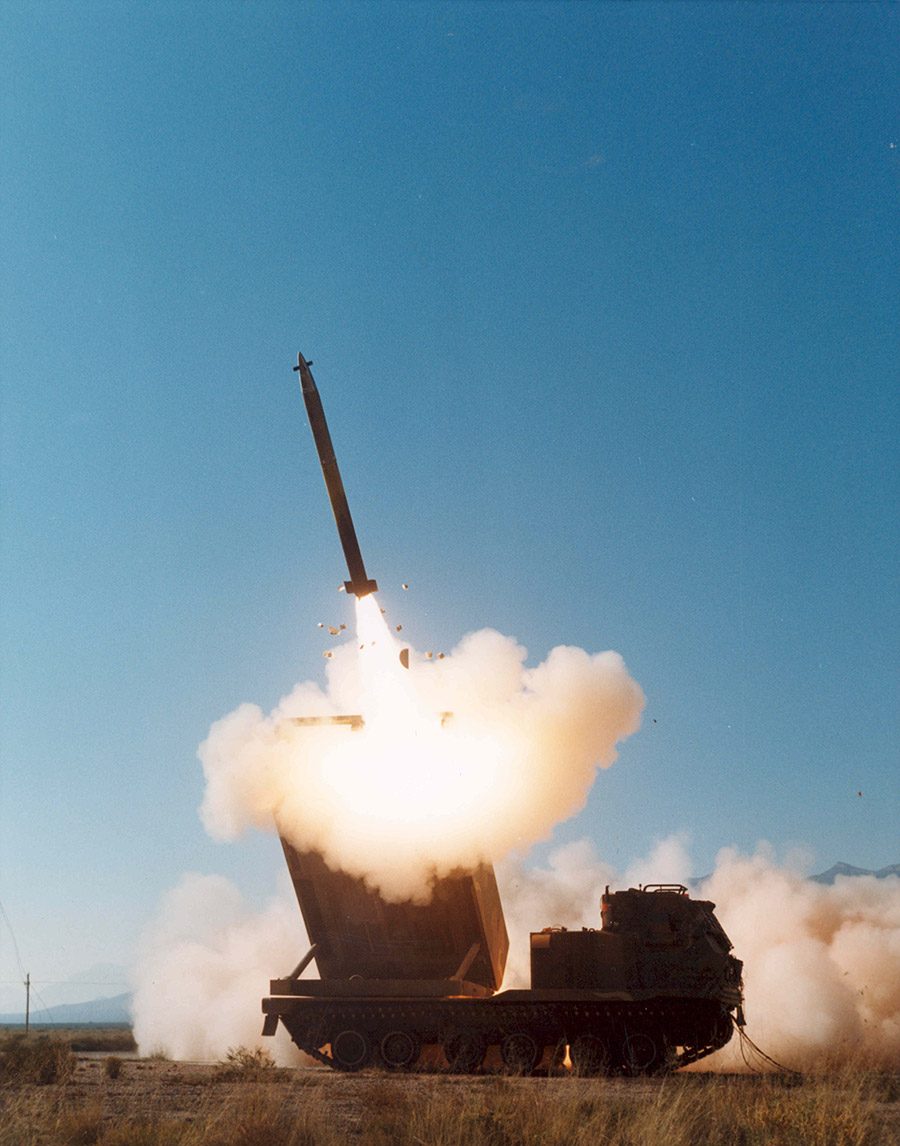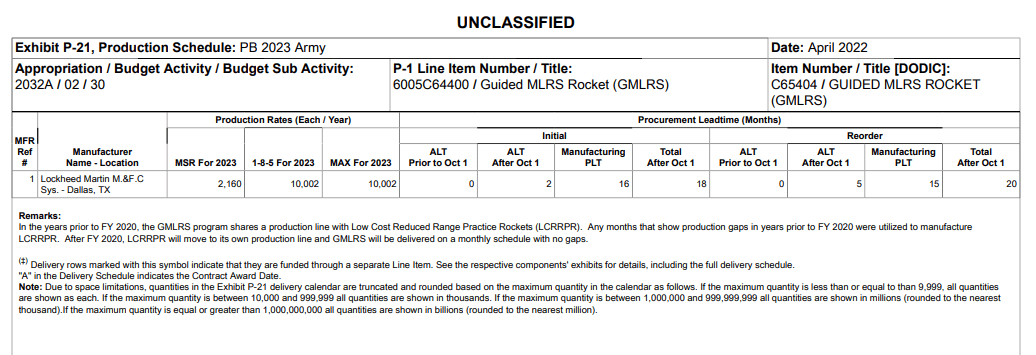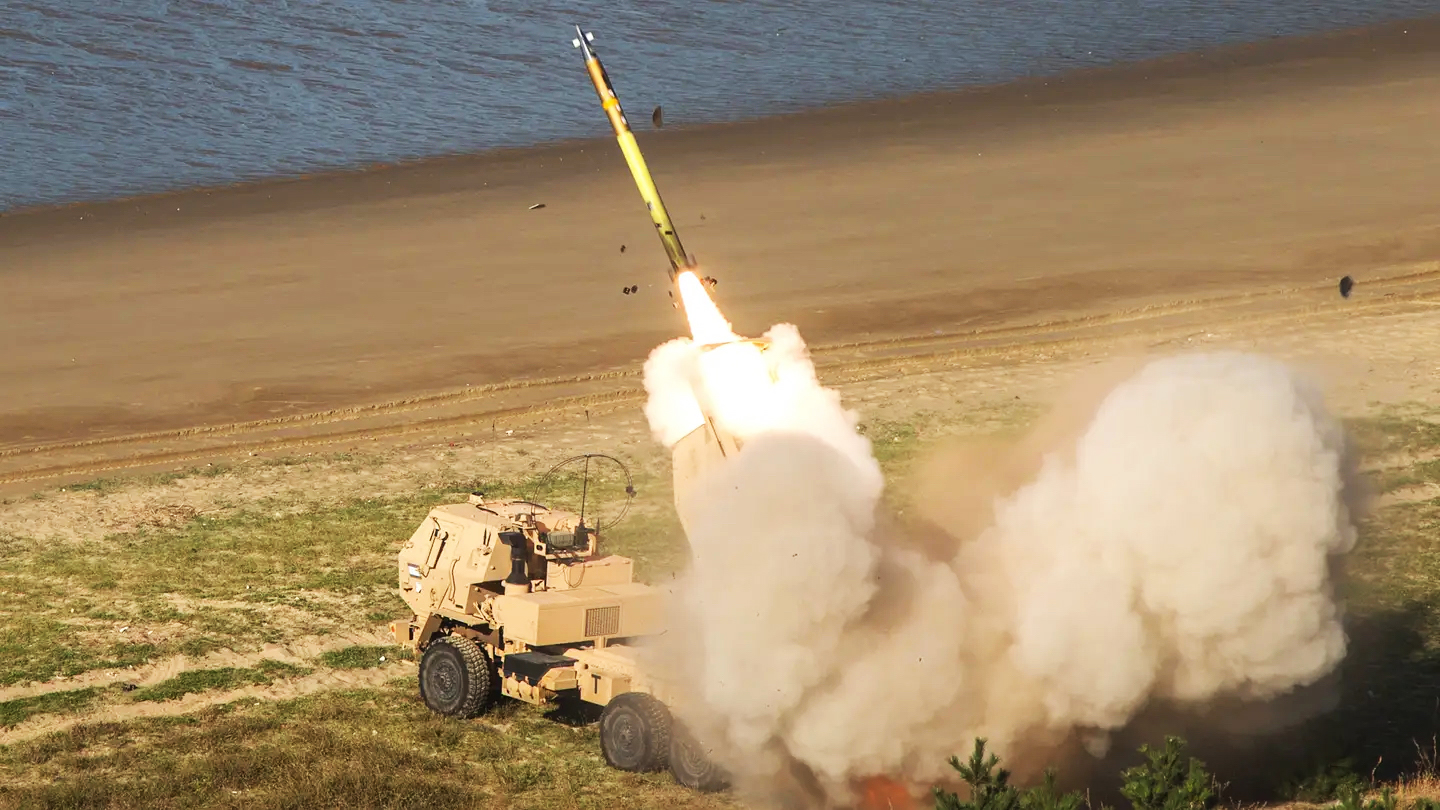In a recent television appearance, Ukrainian Defense Minister Oleksii Reznikov likened his troops’ use of M142 High Mobility Artillery Rocket Systems, or HIMARS, to “a surgeon working with a scalpel” when describing the recent strike on the Antonovsky bridge.
And Tuesday, U.S. Defense Secretary Lloyd Austin had a call with Reznikov to talk about, among other things, the four additional HIMARS the U.S. recently promised Ukraine. That brings the U.S.’s total multiple launch rocket system (MLRS) commitment to 16 so far (each costs just shy of $7 million.) The number of precision-guided rockets supplied for those systems has not been made public by the Pentagon.
The constant refrain from Ukraine has been a call for more – as many as 100 HIMARS, which equates to about 20 percent of the entire U.S. stock for both the Army and Marines, which each use HIMARS. But over the long haul, Kyiv should worry more about its supply of munitions, not the launch vehicles themselves, some experts say.
“As long as you only have 12 or 20 HIMARS systems, the [munitions] burn rate is not going to be a near-term problem,” retired Marine Col. Mark Cancian, who worked at the Office of Management and Budget on Pentagon procurement programs and is now a senior adviser with the Center for Strategic & International Studies, told The War Zone. “When you start getting more than that, and you start looking out three months, four months, I think at the end of four months, you may just run out.”

In a Twitter thread on Monday, retired Army Lt. Gen. Mark Hertling, who served as the Commanding General of US Army Europe and Seventh Army, also raised alarms about the rate at which Ukrainian troops are firing off their stocks of HIMARS munitions.
“Smart planning consideration of our Department of Defense (& all the nations that are supplying MLRS) is this: How much risk do we take in giving UKR an exceedingly large # of our smart weapons? And…What if, in the near future, we face this or another enemy in a conflict?”
While it is unknown how many rockets the Ukrainians have fired from the HIMARS it already has, Hertling estimated that 16 such systems – which are pre-loaded with six-round pods – each firing a full volley just twice a day would burn through about 5,800 rockets a month.
How Much Is Not Enough?
The HIMARS can fire a variety of 227mm rockets, including Guided Multiple Launch Rocket System (GMLRS) types made by Lockheed Martin, as well as the Army Tactical Missile System (ATACMS) short-range ballistic missiles. So far, the U.S. has only provided Ukraine with an unpublicized amount of M31 rockets with 200-pound class unitary warheads, which are GPS/INS guided and can hit targets at a distance of around 43 miles (70 kilometers.) The Biden administration is reluctant to provide longer-range and harder-hitting ATACMS out of concern that it might rile the Russians. In particular, it could provide a means for Ukraine to execute precision strikes on a large variety of targets well into Russia.
GMLRS rockets, which can also be fired by the M270 multiple launch rocket system (MLRS) being shipped to Ukraine through other nations, “provide 24/7, all-weather precision fires to engage both area and point targets at short, medium, and long ranges, according to the Army Presidential Budget Justification Book.
The Army expects to pay about $168,000 for each GMLRS when it goes to buy more in Fiscal Year 2023, according to the budget.
The munitions the U.S. is sending to Ukraine are being drawn down from existing supplies.

Prior to Fiscal Year 2021, the Pentagon had purchased slightly more than 50,000 GMLRS of all variants, according to the Fiscal Year 2023 U.S. Army Presidential Budget Justification Book.
The GMLRS program currently consists of multiple variants: GMLRS Unitary Warhead utilizes a 200-pound high-explosive warhead to engage point targets with limited collateral damage. GMLRS Alternative Warhead (AW) was developed as a non-cluster munition to engage area or imprecisely located targets. GMLRS Unitary and AW are currently in full rate production and, at the moment, the only variants available.
Meanwhile, an effort is underway to extend the range of GMLRS rockets and, upon completion of key development tests, the Extended Range GMLRS (ER GMLRS) will be considered for cut-in to the GMLRS production contract as early as Fiscal Year 2023, according to the justification book.
On March 4, 2021, Lockheed Martin announced a successful test flight of the ER GMLRS, in an 80-kilometer (49.7 mile) flight demonstration at White Sands Missile Range, New Mexico. During the flight test, the ER GMLRS round was fired from a HIMARS launcher, “meeting test objectives.” The targeted max range for the ER variant is 93 miles, more than doubling that of the standard variant. This is a massive upgrade as a single HIMARS launcher would be able to cover far more territory and reach enemy positions that are well out of reach of GMLRS now.

That range extension “will allow GMLRS to reach targets formerly serviced by the more expensive ATACMS,” according to the justification book. The Army is hoping to begin small purchases of the ER GMLRS in the coming fiscal year depending on the completion of those development tests.
The Army is looking to procure 1,002 Standard Unitary, 3,552 AW, and 120 ER GMLRS in support of its Total Munitions Requirement (TMR), according to the justification book.
Through a review of the budget documents, Cancian said that in addition to the GMLRS already received by the Army, there are another 12,000 in production or on order from Fiscal Year 2021 and Fiscal Year 2022. The budget documents also show the Army is slated to procure another 20,000 of them through Fiscal Year 2027. But at a diminishing pace.

That budget plan calls for the Army acquiring an additional 4,674 GMLRS in Fiscal Year 2023, plus an additional 834 for the Marines. But after that, the proposed annual procurement number for the Army drops significantly, with 3,588 in Fiscal Year 2024, 3,958 in Fiscal Year 2025, 3,816 in Fiscal Year 2026, and 3,996 in Fiscal Year 2027.
In addition, there were 900 GMLRS purchased through Foreign Military Sales (FMS) in Fiscal Year 2019, 1,014 in Fiscal Year 2020 and 2,142 in Fiscal Year 2021.
So in essence, at a pace suggested by Hertling, Ukraine’s GMLRS monthly burn rate would equal about 29% of the entire planned U.S. procurement for the next five years, not withstanding production rates of the ER GMLRS which have yet to be set.
Given those numbers, what does Ukraine’s use of HIMARS portend for that nation, and the U.S., which might find itself needing these systems in case of a possible future conflict with China, Russia, or some other adversary?
Inventory Status
“The HIMARS without GMLRS is useless,” Cancian told The War Zone, adding that the U.S. military GMLRS stocks were already depleted during the wars in Afghanistan and Iraq. Though those wars are over, there is still an ongoing fight against the so-called Islamic State jihadi group and the budget calls for spending about $11.2 million from Operation Inherent Resolve funds to purchase 78 GMLRS for that effort in the coming fiscal year.
“Of the 50,000 [GMLRS] received, the military has probably expended about 20,000,” he said. “I calculated that from what had been paid for in the war funding. So the current inventory is about 30,000.”

While there are differences between how GMLRS and man-portable missile systems are built and procured, Cancian said that if the U.S. provides Ukraine GMLRS at the same rate it has provided the Javelin anti-tank missile systems and the Stinger surface-to-air missiles – about a third of the current inventory – that would be about 10,000 rockets, “which sounds like a lot.”
But less so given the number of HIMARS being sought by Ukraine.
“The Ukrainians keep talking about 100 HIMARS,” said Cancian. “But the problem is you will run out of rockets.”
Ukraine’s GMLRS burn rate is “a wild guess,” he said, taking a slightly different approach than Hertling.
“If each of (the) 16 HIMARS fires three rockets per day, that’s 48 a day or 1,440 per month. 10,000 rockets would last well into 2023 at that rate. On the other hand, if the Ukrainians get the 100 HIMARS they are requesting and each one fires three rockets per day, that’s 300 per day or 9,000 per month.”
And that’s only if each HIMARS, which can fire six rockets at a time, doesn’t release a full volley during each engagement.
“The limitation on HIMARS is the number of rockets available, not the number of launchers,” Cancian reiterated.
What a red line is for the total amount of GMLRS drawn down from U.S. supplies is not yet known. However, the Pentagon seems to indicate that America may not be Ukraine’s lone GMLRS provider.
A number of other countries have HIMARS and during a July 1 press conference, a senior U.S. defense official hinted that the U.S. was looking toward other nations to help provide Ukraine with GMLRS.
In addition to a focus on 155mm artillery ammunition for howitzers supplied by the U.S. and others, “we’re also focused on…the GMLRS,” the official said, speaking on condition of anonymity. “But I don’t want to just speak to U.S. efforts because one of the other things that we’re very active with is asking other countries to support Ukraine with their capabilities.”
While it is unknown how many GMLRS the U.S. has provided Ukraine or how many Ukraine has already fired, at some point, there is a question of how much is too much to be drawn down from U.S. stocks.
“If the United States gives more than a third of its inventory to Ukraine, military planners will warn about excessive risk in US war plans, which count on a number of GMLRS,” said Cancian. “The US total inventory requirement is about 85,000, so the Army is only about a third of the way to the total requirement.”
Supply Chain Stress
As Javelin and Stinger missiles prove to be key weapons in Ukraine’s ongoing defense against the Russian all-out invasion, there were questions raised about how the U.S. would maintain its stocks of those missiles given how many were being shipped out. The brittle and cumbersome supply chains that exist to replace them also quickly became a glaring issue. This was occurring as demand for the weapons spiked due to what the world was seeing in Ukraine. The GMLRS supply and production issues could be similar, if not more pressing if the war drags on for many months.
In May, Lockheed Martin, which also makes the Javelin missiles, announced it was addressing concerns about the continued supply of shoulder-fired Javelin anti-tank missile systems. The company has confirmed that the production rate of the missile will be almost doubled, responding to the demand from Ukraine, as well as the continued requirement for these weapons to arm the United States and other allies and partners.
The maximum annual production rate of GMLRS is about 10,000 or about twice what is currently being called for in the current budget proposal.

Though the annual number of GMLRS procured is set to drop, the number of HIMARS launchers procured is set to increase by 105 between the Fiscal Year 2023 and Fiscal Year 2027, for a total of 545, according to the justification book. So far there is no indication that Lockheed Martin has been asked to ramp up production of GMLRS.
It’s not necessarily unreasonable to expect that GMLRS production will slow as the Army transitions to ER GMLRS, and it’s not clear to what degree ER GMLRS purchases are being factored in now into the future year’s figures.
But could the combination of presidential drawdowns from existing U.S. supplies for Ukraine, increased HIMARS production, and concern about potential future conflicts spark a call for more GMLRS?
“Lockheed Martin has not been formally asked or contracted to increase production capacity,” Angela Marcum, a company spokesperson, told The War Zone Wednesday morning. “However, we’re ready to support increase in demand if requested.”
When asked for comment, the State Department, responsible for international arms sales, pointed The War Zone to remarks made about the general state of U.S. arms procurement by Assistant Secretary Jessica Lewis to defense manufacturers at the Farnborough Airshow.
“It is vital..that we – government and industry – work together to shorten delivery times for critical military systems and equipment,” she said. “Current production cycles are based on a deliberate peacetime procurement cycle, where production timelines often range into many years.”
“But those days are over,” she said.
“We are no longer in a peacetime procurement scenario, and the current Ukraine crisis has highlighted the significant issues we face with long production timelines in crises such as the one we’re in. Even before the war in Ukraine started, long production timelines were one of the top concerns we consistently heard from our partners.”
“Frankly, the long lead times are affecting our competitiveness as a defense partner and preventing us from providing much-needed support to some of our closest partners when they need it. With increased demand and rising defense budgets, the demand for U.S. defense equipment will only continue to grow.”
The U.S. government, she added, “is looking closely at what we can do to improve production timelines, but we cannot do this on our own. Industry must step up to play a key role in these efforts. We will be looking to industry for your ideas and creative solutions on how to improve the speed of production in order to meet these critical needs.”
We have also reached out to the Pentagon and Army for comment and will update this story with any response we receive.
But as Ukraine continues to press for more HIMARS, any decision on how many may be gifted by the U.S. has to take into account the number of available GMLRS. This is especially true as the U.S. keeps a wary eye toward the Pacific and increasing tensions with China.
The bottom line is that these weapons take long lead times to procure and it seems clear that the stockpiles that exist, both in the U.S. and among its allies, may be under-resourced, at least based on what we are seeing even in the relatively geographically limited conflict in Ukraine.
Contact the author: howard@thewarzone.com
